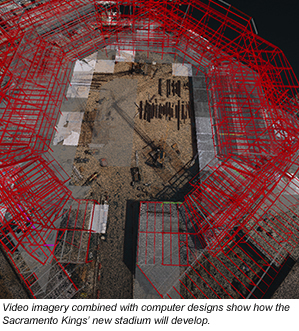 A drone hovers over a major construction site shooting video progress photos, a daily or weekly occurrence. One of the concrete finishing crew becomes aware of the buzzing of the quadcopter hovering over them and asks the foreman, “Is that drone watching me work?” The foreman had been told at the job briefing that morning that the build was three days behind schedule and everyone on the concrete crew was going to have to up their game to get back on schedule. The foreman answers the worker, “Naw, the drone is just monitoring progress and not specific workers on the site.” Although he thought that they might be since he knew that the software makes it possible to monitor crew members even though drones had only been used for the last year on their builds. Science fiction? Not at all.
A drone hovers over a major construction site shooting video progress photos, a daily or weekly occurrence. One of the concrete finishing crew becomes aware of the buzzing of the quadcopter hovering over them and asks the foreman, “Is that drone watching me work?” The foreman had been told at the job briefing that morning that the build was three days behind schedule and everyone on the concrete crew was going to have to up their game to get back on schedule. The foreman answers the worker, “Naw, the drone is just monitoring progress and not specific workers on the site.” Although he thought that they might be since he knew that the software makes it possible to monitor crew members even though drones had only been used for the last year on their builds. Science fiction? Not at all.
The FAA has issued over 1,000 special permits for the use of drones in the US. Many of those permits have been issued to construction companies who are working to catch up on ways that they can be used to improve productivity on their builds. Already they have found that they can help make construction more accurate as in the Trimble use of GPS and lasers in the layout of buildings on a site; to the shooting of progress photos to help make projects safer; even to the use of video and time lapse photography to spot areas of the build where progress was lagging and where additional crews and materials might need to help the build stay on schedule.
Time is money on a construction site. Drones are tools that can help. However, as was recently reported in an article in the MIT Technology Review, Turner, the general contractor on the Sacramento Kings Arena build in downtown Sacramento, is being plagued with new questions about worker privacy where drones are being used to track daily or weekly progress.
Even though Turner issued a statement that said the drones were only being used for progress monitoring and not individual worker monitoring, the article made me wonder how far the monitoring can go. We’ve seen that drones and stationary cameras can record video for safety, security, and job progress. Now, as the new technology is incorporated into the industry, the technology exists, as shown in the video in the article, to identify and monitor all of the actions of the workers on a jobsite.
That becomes a two edged sword. First, the use of drones, BIM and other new communication techniques can bring construction scheduling, monitoring and building out of the old “two inches at a time” mentality into the 21st century and improve the safety and productivity on a build. Second, it will likely open up new legal areas and contract clauses that either permit or deny the use of that technology on jobsites as we go through this transition period.
What the foreman probably said to the concrete worker was, “You bet and you had better get back on the job or you won’t have one for long.”


